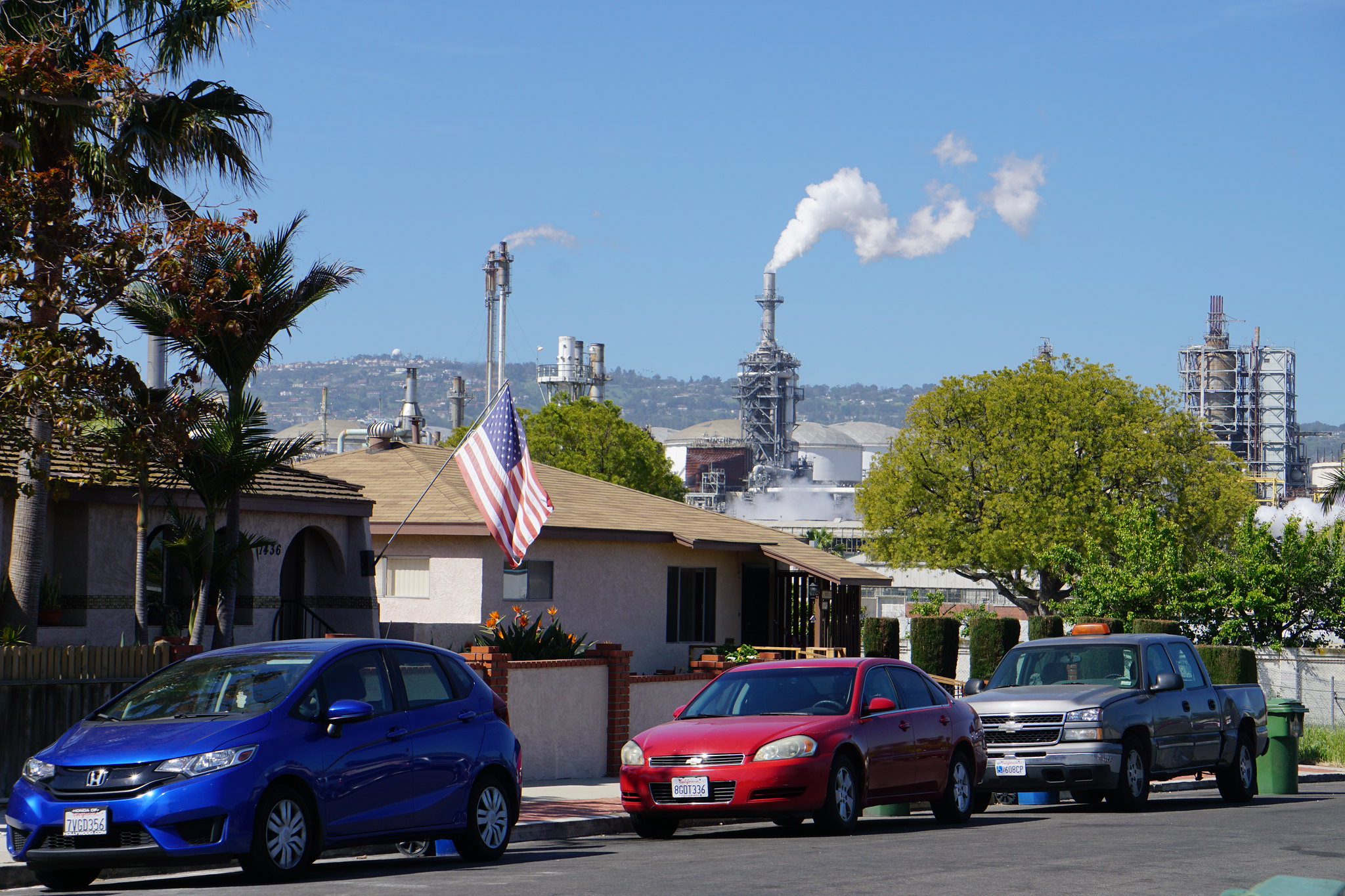Listen to the audio version >>
This commentary analyzes Joe Biden’s “Plan for Climate Change and Environmental Justice” released in August.[1] The following commentary, “The Biden Climate Plan: Part 2: An Arena of Struggle,” will consider the struggles that are likely to emerge over what parts of the plan can and should be implemented.[2]
Author: Guardian News | Watch the video »
Political platforms and campaign promises are notoriously prone to abandonment or perversion. Yet they also set much of the framework for political debate and governance. For those who advocate the goals of the Green New Deal, holding political leaders like President-elect Joe Biden accountable to the best of their campaign commitments can sometimes be a significant means of affecting what they actually do.
The purpose of this commentary is not to rate the Biden climate plan, but to identify those parts of it that provide genuine opportunities for the climate protection and social redistribution goals of the Green New Deal and those parts that provide dangerous handles for false flag, phony climate advocates who want to pervert these goals for their own ends.
That struggle has already begun. For example, the Biden plan stated flatly that his presidency would end fossil fuel subsidies. Then, in the midst of the Democratic convention, the Democratic National Committee said that on the contrary fossil fuel subsidies would continue. Then Biden’s staff said that Biden’s position was unchanged and that he would end fossil fuel subsidies.[3] This episode provides one dramatic preview of the struggles that lie ahead.
The Biden administration is coming to power in the midst of the COVID-19 pandemic, the resulting COVID economic crisis, a contested election, and the resulting constitutional crisis. Its first months are likely to be shaped by the need for an emergency response. Its later development will depend on the interaction of popular movements with the machinations of their enemies–and no doubt the emergence of unanticipated factors that are now beyond prediction. Nonetheless, Biden’s campaign platform is likely to set much of the frame for climate policy and provide opportunities for both the supporters and the opponents of genuine climate and worker protection.
Frame

Photo: “Toxic Tour of Wilmington, CA” by Emmett Institute at UCLA School of Law is licensed under CC BY-NC 2.0
The Biden “Plan for Climate Change and Environmental Justice” opens with a forthright statement of the climate threat.
From coastal towns to rural farms to urban centers, climate change poses an existential threat–not just to our environment, but to our health, our communities, our national security, and our economic well-being. It also damages our communities with storms that wreak havoc on our towns and cities and our homes and schools. It puts our national security at risk.
If the global temperature continues to increase at the current rate and surpasses 1.5°C, “the existential threat to life will not be limited to just ecological systems, but will extend to human life as well.” The opening sections of the Biden plan lay out a frightening litany of facts on the devastating effects of climate change.
By starting from the existential threat of climate change, the Biden plan defines climate protection not just as one item on a long list of desirable objectives, but as an existential necessity.
To address the climate emergency, the Biden plan promises to ensure that the U.S. “will eliminate GHG emissions in the power sector by 2035” and achieve a “100% clean energy economy and net-zero emissions no later than 2050.”[4] It is important to note that a “clean energy economy” is sometimes defined to include such technologies as nuclear energy and carbon capture and sequestration (CCS – sometimes touted as “clean coal”). Likewise, “net-zero emissions” can mean continued GHG emissions that are compensated for by the withdrawal of comparable quantities of GHGs from the atmosphere. Biden’s 100% target probably meets the requirements of the Paris climate agreement but far less rapidly than the targets proposed in the Green New Deal resolution sponsored by Alexandria Ocasio-Cortez and Ed Markey.
The Biden plan describes the Green New Deal as a “crucial framework for meeting the climate challenges we face.” In particular it holds that “our environment and our economy are completely and totally connected.” The Biden plan addresses fears that climate policy will threaten jobs by emphasizing climate protection as a means for creating jobs and “the new economy of the future.” The response to climate change can create “more than 10 million well-paying jobs.”
The Biden climate plan frame provides a basis for demanding climate policy accountability. Whatever happens, advocates of worker-friendly climate protection can demand that this existential threat be met, and can fight any policies that fail to meet it.
Executive Action

Stock photo from Canva
The Biden plan pledges that on its first day the Biden administration will sign a series of new executive orders to use the “full authority of the executive branch” to significantly reduce emissions. These will include:
- Methane pollution limits
- Federal procurement system to drive toward 100% clean energy and zero-emissions vehicles
- Clean Air Act implementation and fuel economy standards
- 100% new light and medium duty vehicles electrified
- Advanced biofuels
- Appliance and building efficiency standards
- Consider greenhouse gas emissions in federal infrastructure investment
- Require any federal permitting decision to consider the effects of greenhouse gas emissions and climate change
- Companies disclose climate risks and greenhouse gas emissions in their operations and supply chains
- Conserve 30% of American’s lands and waters by 2030
- Permanently protect Arctic National Wildlife Refuge
- Ban new oil and gas permitting on public lands and waters
- Modifying royalties to account for climate costs
These provide a specific set of day-one promises for unilateral presidential action to which the new president can and should be held accountable. Taken together they could make significant reductions in GHG emissions, though their impact will depend on the nitty-gritty details of the executive orders and their execution.
Congressional Action

Stock photo from Canva
The prospects for Congressional action on climate are very much up in the air, but Biden’s proposals are at the least likely to shape the debate. The Biden plan demands that the new Congress pass a three-part program in its first year.
Enforcement: The first part is an “enforcement mechanism” to achieve “legally-binding emissions reductions.” This mechanism will be based on the principles that “polluters must bear the full cost of the carbon pollution they are emitting” and that emissions reduction must be “economy-wide” rather than affecting “just a few sectors.”
The enforcement mechanism must achieve net-zero emissions no later than 2050. The mechanism must include milestone targets for 2025. Those targets are not spelled out and will undoubtedly be an important subject of conflict.
The nature of this “enforcement mechanism” is also not spelled out. If it is to achieve “legally-binding emissions reductions” reaching net-zero by 2050, it must legally require GHG emitters to reduce their collective emissions at the rate necessary to reach that goal. Significantly, frequently proposed mechanisms sometimes referred to as “market-based,” such as cap-and-trade, carbon taxes, and carbon offsets, are not mentioned, though they are not explicitly excluded. The plan touts the Obama Clean Power Plan and a variety of its “green” regulatory and investment policies, and proposes many additional regulatory and investment programs to reduce GHG emissions.
The plan says it will “hold polluters accountable.” “Allowing corporations to continue to pollute – affecting the health and safety of both their workers and surrounding communities – without consequences perpetuates an egregious abuse of power.” Biden will direct his EPA and Justice Department to “pursue these cases to the fullest extent permitted by law and, when needed, seek additional legislation as needed to hold corporate executives personally accountable – including jail time where merited.” (The Obama Clean Power Plan provided standards for total emissions reductions within a state, but not for individual or corporate polluters.) Such legal accountability for GHG emissions could be a powerful means of climate protection. It is not stated on whom legal requirements will be enforced and how required reductions will be determined.

Stock photo from Canva
Investment in research: The Biden plan will invest $400 billion over ten years in “clean energy research and innovation.” It will establish ARPA-C, an Advanced Research Projects Agency focused on climate. Its research agenda will represent an “all the above” approach that includes many environmentally-sound strategies like carbon-neutral buildings and half-a-million electric vehicle charging stations but also many more questionable ones like nuclear reactors and carbon capture and storage. (The looming struggle over these techniques will be discussed in the next commentary.) The research agenda includes:
- grid-scale storage
- small modular nuclear reactors
- zero net energy buildings
- using renewables to produce carbon-free hydrogen
- decarbonizing industrial heat
- carbon-neutral construction materials
- decarbonizing the food and agriculture sector
- leveraging agriculture to remove carbon dioxide from the air and store it in the ground
- new, sustainable fuels for aircraft
Deployment: First-year legislation will provide incentives for the rapid “deployment” of clean energy technology innovations across the economy, “especially in communities most impacted by climate change.” Every infrastructure investment that receives federal funding “should reduce climate pollution” as much as possible. How such reductions will be evaluated and enforced is not spelled out.
The plan proposes to reduce the carbon footprint of the U.S. building stock 50% by 2035. It will fund states and cities to adopt strict building codes and train builders and inspectors. It will make housing for low-income communities more efficient; provide incentives for “deep retrofits”; and encourage “denser, more affordable housing near public transit.”
The plan proposes “empowering local communities to develop transportation solutions,” including such options as transit, dedicated bicycle and pedestrian thoroughfares, and first- and last-mile connections. It will modify local transportation funding to increase flexibility for state and local governments. It will restore incentives for electric vehicles and establish 500,000 new public charging outlets by the end of 2030. It will fund expansion and modernization of passenger and freight rail systems.
The plan will invest in “climate-friendly farming” such as methane digesters and conservation programs for cover crops and other practices “aimed at restoring the soil and building soil carbon.”
The plan proposes a national strategy to develop a low-carbon manufacturing sector in every state. It will connect research universities, community colleges, incubators and accelerators, manufacturing institutes and employers, unions, and state and local governments. It will provide tax credits and subsidies for businesses to “upgrade equipment and processes, invest in expanded or new factories, and deploy low-carbon technologies.” These credits and subsidies will only be available as long as “all stakeholders are part of the process of determining a bottom-line win for jobs, workers, clean energy, and long-term community investment.” The details of that process are not spelled out. No plans describe “deployment” of the more questionable technologies included in the research agenda, such as nuclear reactors and carbon capture and storage.
While the Biden plan is not as comprehensive as that proposed in the Democratic primaries by Jay Inslee or as radical as Bernie Sanders’, it has the potential to make very substantial reductions in GHG emissions while creating substantial numbers of climate jobs and a more equal society. Its frequent vagueness, however, also leaves open possibilities for inadequate GHG reductions and harmful policies.[5] The next commentary, “The Biden Climate Plan: Part 2: An Arena of Struggle,” will examine the conflicts that are likely to arise from them, the parts GND advocates should fight for, and the parts they should fight against. And it will discuss how to hold Biden accountable to the frame, goals, and commitments promised in his plan.
[1] Joe Biden, “Plan for Climate Change and Environmental Justice.”
[2] This analysis is based exclusively on the “Biden Plan for Climate Change and Environmental Justice.” It does not analyze other parts of his “Build Back, Build Better” plan. Similarly, the Biden climate plan’s international proposals are not addressed here.
[3] Ben German, “Feud over fossil fuel subsidies spotlights Democrats’ climate fissures,” Axios, August 20, 2020. See also Tamara Toles O’Laughlin, “When it Comes to Climate Change, It’s Joe Biden Versus the DNC,” The Nation, August 21, 2020.
[4] For comparison, see “Resolution Recognizing the Duty of the Federal Government to Create a Green New Deal,” the Ocasio-Cortez Markey Green New Deal resolution proposed to achieve “net-zero greenhouse gas emissions” and 100% of power demand through “clean, renewable, and zero-emission energy sources” through a ten-year mobilization. President Obama’s Clean Power Plan proposed to reduce carbon dioxide emissions by 32 percent from 2005 levels by 2030–and provided no targets beyond that date. The White House, “Climate Change and President Obama’s Action Plan,” December, 2015.
[5] For an environmentalist critique of the Biden plan, see “Biden’s climate plan a half measure to stop climate change,” Friends of the Earth, June 4, 2019.

